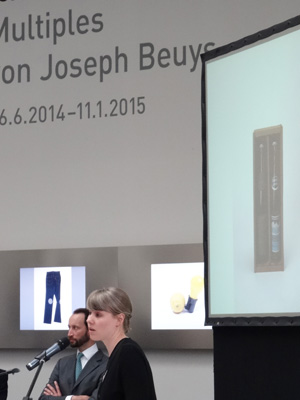The Harvard Art Museums have trained scores of museum leaders who have gone on to make remarkable contributions to the curatorial, conservation, and education fields. We offer a number of opportunities for emerging graduate and postgraduate scholars interested in the production and presentation of original scholarship within the museum context. In this regular series of interviews, we catch up with these museum professionals to see where they are now.
Maja Wismer was the Renke B. and Pamela M. Thye Curatorial Fellow in the Busch-Reisinger Museum from 2012 to 2014. Following her recent completion of this fellowship, Wismer returned to Basel, Switzerland, where she is working on her Ph.D. at the University of Basel. This summer, as part of a research collaboration between the Busch-Reisinger Museum and the Pinakothek der Moderne, in Munich, Germany, Wismer is co-curating an exhibition of multiples by German artist Joseph Beuys, at the Pinakothek.
Q You’re writing your dissertation on Joseph Beuys and his multiples. How has your fellowship at the Harvard Art Museums shaped your academic research?
A An essential part of my fellowship was to curate different combinations of Beuys multiples to be displayed within the permanent collections galleries. This involved going through the more than 600 multiples in the Busch-Reisinger Museum’s collection, object by object, grouping them, and seeing connections among them as well as to works by Beuys’s international contemporaries. My research benefitted significantly from this process and from very productive discussions with my colleague Jennifer Quick, a graduate student in Harvard’s History of Art and Architecture department. Together we orchestrated the selection of Beuys multiples, Fluxus multiples, artists’ books and other ephemera, which will be on view in the museums’ new Sixties Gallery. My research has also been informed by looking at the work of this German artist—and the timespan these works came into being, which roughly coincides with the second half of the Cold War—from the American perspective.
Q Following the completion of your Ph.D., where do you envision yourself professionally?
A I would like to contribute and shape the exhibition program of a museum with a substantial collection of art of the last and the present century. My training at the Harvard Art Museums has reinforced my desire to work at the curatorial level to expand collecting boundaries and to focus on the permanent collection, continuously recontextualizing it through temporary exhibitions. As a curator, I would like to make sure the artworks and the institution continue to resonate with contemporary audiences.
Q Was there a specific event during your fellowship at the Harvard Art Museums that you found particularly powerful?
A Installing the galleries of the new facility with the curators of the Division of Modern and Contemporary Art was a great experience. The process was highly collaborative; together we tested our concepts in workroom mock-ups and saw them materialized in the finished galleries. Seeing it all come together on site—what needed to be tweaked and rethought, and how the physical space (light, proportions, doorways, sightlines, etc.) influenced the installation—was a powerful reminder that museum work is anything but merely administrative.



